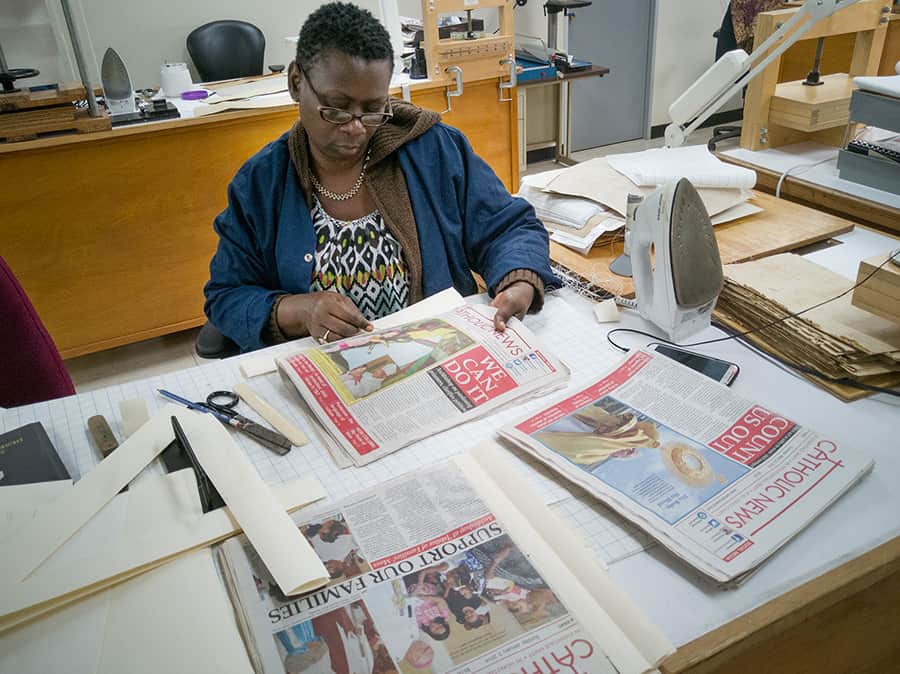
Above: Janice Jeffrey of the National Archives prepares issues of the Catholic News for preservation. Photo by Mark Lyndersay.
BitDepth#1102 for July 18, 2017
Kwynn Johnson, artist and curator, has a special place in her heart for The Catholic News. Between 2005 and 2011, she wrote about art for the paper under editor June Johnston, an experience she still recalls with a wistful smile.
I completely understand. In the late 1970’s I found myself, shall we say, “between newspapers” as a young writer and journalist and found a warm and comfortable reception working with Father Nicholson at the Catholic News for several years.
And Sister Marie Therese never failed to keep a watchful eye on what I might be getting up to in the pages of the paper.
Two months ago the newspaper had a remarkable birthday. It celebrated 125 years of weekly publication in May and yesterday, there was a little party at the Apostolic Nunciature of the Holy See to celebrate an even more remarkable milestone in its existence, the unveiling of a searchable online archive of all 55,000 pages published in the 6,500 weeks it has put an issue on the pews of local Catholic churches. Existing PDFs of the publication, published since 2013, were compatible with the archive and were directly added to the online archive.
In regional Anglophone newsprint, The Jamaica Gleaner is older at 183 and the T&T Guardian follows close behind with the celebration of its own centenary this year.
“I have a history of working with archives and collections,” Kwynn Johnson said.
“I curated the 3Canal and Machel Montano archives, the Caribbean School of Dancing’s costumes, I’m familiar with gathering records and collectibles.”
“I believe that these resources are important to understanding. The society isn’t very interested in large measure with what archives are and what they can do.”
“It’s particularly important in a society like ours which continues to erode, but this is not an attraction; it’s too important to be sentimental. It’s a pool of primary data to probe.”
Which isn’t to say that there hasn’t been a moment of two of sentiment for Johnson, who discovered her great-great-grandfather’s obituary in the paper while reading the collection.

Kwynn Johnson leafs through a bound volume of early Catholic News issues in the Reprographics Lab of the National Archives. Photo by Mark Lyndersay.
And in the course of the project, Kwynn Johnson has skimmed, read, fixated on or flipped through every page that went online yesterday. And she has favorites.
“Between 1892 to 1941 and then from 1974 to 1994 are particularly interesting dates of publication for the paper.”
Making something of this scale happen took some serious but quiet leveraging of interested parties.
After Johnson drew the project to their attention, the Vatican Embassy took an interest in this record of the church in the new world and assigned funds it reserves for such archiving projects.
She viewed the microfilm archive of the collection at UWI, but scattershot imaging made that version unworkable.
There are four full collections of the printed Catholic News in T&T, one at the Archbishop’s house, a part of a collection of artifacts held there, one at the Seminary, one at the offices of the Catholic News and one at the National Archives, which stores 100 million pages in its newspaper vault alone.
Getting the buy-in of the National Archives’ Avril Belfon may have been the easiest part of making the project happen.
“Avril Belfon recognized the value of the of proceeding with the project and creating a pioneering work bringing the full run of a newspaper into the digital realm,” said Johnson.
To index and keyword the collection, Kwynn Johnson began working in the Reprographic Lab in March 2016, reading each page of the paper and making notes.
By August 2016, 20 years had already been scanned and Johnson would remain on the premises full time on the project until February 2017.
Malachi Alexis, a young student of records management and library services and Deborah Best did the work of bringing the brown, crumbling atoms of the ageing pages of the paper into the digital realm.
Their tool was a Zeutschel scanner (http://ow.ly/9eko30dDBax), a massive instrument of technology that stands eight feet tall with a bed you can, but shouldn’t, lie down on. This is a scanner that has more in common with a meat locker, if a meatlocker had a high-tech crane attached. It’s also operated with foot switches, like a proper industrial tool.
The Zeutschel tracks scanning sensors over the open pages of the bound copies of the paper, scanning high resolution TIFF files at 300 dpi. A double page spread of the Catholic News clocks in at 340MB uncompressed. For large images, the works are scanned at high resolution (view a video here: https://technewstt.com///bd1102).
A smaller version of the file is resaved as a PDF to create the basis of the online archive. Then the process begins again after turning the page.
The digital archive is a feature of the Catholic News website which has been online since 1997 and is undergoing a redesign.
Walk-in visitors to the National Archive can browse the online files for free, but access through the Catholic News website will be via paid subscription. It will probably be worth the fee for researchers and even for old columnists like me, who just want to be appalled at their 40-year-old words.


